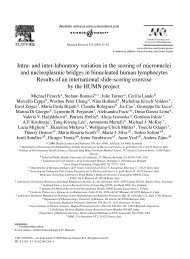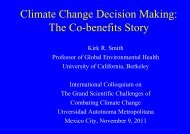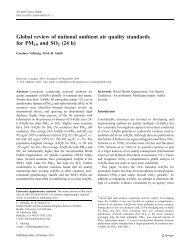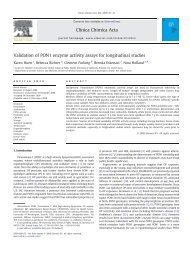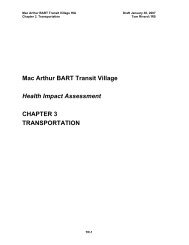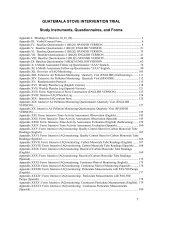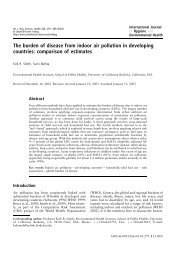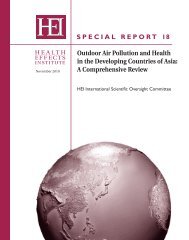Prevalence of Chronic Obstructive Pulmonary Disease in China
Prevalence of Chronic Obstructive Pulmonary Disease in China
Prevalence of Chronic Obstructive Pulmonary Disease in China
You also want an ePaper? Increase the reach of your titles
YUMPU automatically turns print PDFs into web optimized ePapers that Google loves.
<strong>Prevalence</strong> <strong>of</strong> <strong>Chronic</strong> <strong>Obstructive</strong> <strong>Pulmonary</strong> <strong>Disease</strong><strong>in</strong> Ch<strong>in</strong>aA Large, Population-based SurveyNanshan Zhong 1 , Chen Wang 2 , Wanzhen Yao 3 , P<strong>in</strong>g Chen 4 , Jian Kang 5 , Shaoguang Huang 6 , Baoyuan Chen 7 ,Changzheng Wang 8 , Diantao Ni 9 , Yum<strong>in</strong> Zhou 1 , Shengm<strong>in</strong>g Liu 1,10 , Xiaop<strong>in</strong>g Wang 11 , Dali Wang 12 , Jiachun Lu 13 ,J<strong>in</strong>gp<strong>in</strong>g Zheng 1 , and Pix<strong>in</strong> Ran 11 Guangzhou Institute <strong>of</strong> Respiratory <strong>Disease</strong>s, The First Affiliated Hospital, Guangzhou Medical College, Guangzhou, Guangdong, Ch<strong>in</strong>a; 2 Beij<strong>in</strong>gInstitute <strong>of</strong> Respiratory Medic<strong>in</strong>e, Beij<strong>in</strong>g Chaoyang Hospital, Capital University <strong>of</strong> Medical Sciences, Beij<strong>in</strong>g, Ch<strong>in</strong>a; 3 The Third Hospital, Pek<strong>in</strong>gUniversity, Beij<strong>in</strong>g, Ch<strong>in</strong>a; 4 The Shenyang Military General Hospital, Shenyang, Liaon<strong>in</strong>g, Ch<strong>in</strong>a; 5 The First Affiliated Hospital, Ch<strong>in</strong>a Medical University,Shenyang, Liaon<strong>in</strong>g, Ch<strong>in</strong>a; 6 Ruij<strong>in</strong> Hospital, Shanghai Jiaotong University, Shanghai, Ch<strong>in</strong>a; 7 The General Hospital, Tianj<strong>in</strong> Medical University, Tianj<strong>in</strong>,Ch<strong>in</strong>a; 8 X<strong>in</strong>qiao Hospital, The Third Military Medical University, Chongq<strong>in</strong>g, Ch<strong>in</strong>a; 9 Xij<strong>in</strong>g Hospital, The Fourth Military Medical University, Xi’an,Shanxi, Ch<strong>in</strong>a; 10 The First Affiliated Hospital <strong>of</strong> J<strong>in</strong>an University, Guangzhou, Guangdong, Ch<strong>in</strong>a; 11 The First Municipal People Hospital <strong>of</strong> Shaoguan,Shaoguan, Guangdong, Ch<strong>in</strong>a; 12 The Second Hospital <strong>of</strong> Liwan District <strong>of</strong> Guangzhou, Guangzhou, Guangdong, Ch<strong>in</strong>a; and 13 Department <strong>of</strong>Epidemiology, Guangzhou Medical College, Guangzhou, Guangdong, Ch<strong>in</strong>aRationale: The prevalence <strong>of</strong> chronic obstructive pulmonary disease(COPD) <strong>in</strong> Ch<strong>in</strong>a is largely unknown.Objectives: To obta<strong>in</strong> the COPD prevalence <strong>in</strong> Ch<strong>in</strong>a through a largepopulation,spirometry-based, cross-sectional survey <strong>of</strong> COPD.Methods: Urban and rural population-based cluster samples wererandomly selected from seven prov<strong>in</strong>ces/cities. All residents 40 years<strong>of</strong> age or older <strong>in</strong> the selected clusters were <strong>in</strong>terviewed with a standardizedquestionnaire revised from the <strong>in</strong>ternational BOLD (Burden<strong>of</strong> <strong>Obstructive</strong> Lung <strong>Disease</strong>s) study. Spirometry was performed onall eligible participants. Patients with airflow limitation (FEV 1 /FVC ,0.70) were further exam<strong>in</strong>ed by post-bronchodilator spirometry,chest radiograph, and electrocardiogram. Post-bronchodilator FEV 1 /FVC <strong>of</strong> less than 70% was def<strong>in</strong>ed as the diagnostic criterion <strong>of</strong> COPD.Measurements and Ma<strong>in</strong> Results: Among 25,627 sampl<strong>in</strong>g subjects,20,245 participants completed the questionnaire and spirometry(response rate, 79.0%). The overall prevalence <strong>of</strong> COPD was 8.2%(men, 12.4%; women, 5.1%). The prevalence <strong>of</strong> COPD was significantlyhigher <strong>in</strong> rural residents, elderly patients, smokers, <strong>in</strong> thosewith lower body mass <strong>in</strong>dex, less education, and poor ventilation <strong>in</strong>the kitchen, <strong>in</strong> those who were exposed to occupational dusts orbiomass fuels, and <strong>in</strong> those with pulmonary problems <strong>in</strong> childhoodand family history <strong>of</strong> pulmonary diseases. Among the patients whohad COPD, 35.3% were asymptomatic; only 35.1% reported lifetimediagnosis <strong>of</strong> bronchitis, emphysema, or other COPD; and only 6.5%have been tested with spirometry.Conclusions: COPD is prevalent <strong>in</strong> <strong>in</strong>dividuals 40 years <strong>of</strong> age or older<strong>in</strong> Ch<strong>in</strong>a.Keywords: chronic obstructive pulmonary disease; prevalence;epidemiology; cross-sectional studies; GOLD(Received <strong>in</strong> orig<strong>in</strong>al form December 2, 2006; accepted <strong>in</strong> f<strong>in</strong>al form June 13, 2007)Supported by Ch<strong>in</strong>ese Central Government key research projects <strong>of</strong> the 10thnational 5-year development plan grants 2001BA703B03(A) (P.R.) and <strong>in</strong> part byGuangdong key research project grant B30301 (P.R.).Correspondence and requests for repr<strong>in</strong>ts should be addressed to Pix<strong>in</strong> Ran,Ph.D., Guangzhou Institute <strong>of</strong> Respiratory <strong>Disease</strong>s, The First Affiliated Hospital,Guangzhou Medical College, 151 Yanjiang Road, Guangzhou, Guangdong,510120, Ch<strong>in</strong>a. E-mail: pxran@gzhmc.edu.cnThis article has an onl<strong>in</strong>e supplement, which is accessible from this issue’s table <strong>of</strong>contents at www.atsjournals.orgAm J Respir Crit Care Med Vol 176. pp 753–760, 2007Orig<strong>in</strong>ally Published <strong>in</strong> Press as DOI: 10.1164/rccm.200612-1749OC on June 15, 2007Internet address: www.atsjournals.orgAT A GLANCE COMMENTARYScientific Knowledge on the Subject<strong>Chronic</strong> obstructive pulmonary disease is the fourth lead<strong>in</strong>gcause <strong>of</strong> morbidity and mortality <strong>in</strong> the United States,but its prevalence <strong>in</strong> Ch<strong>in</strong>a is largely unknown.What This Study Adds to the FieldCOPD is prevalent and underrecognized <strong>in</strong> <strong>in</strong>dividuals 40years <strong>of</strong> age or older <strong>in</strong> Ch<strong>in</strong>a.<strong>Chronic</strong> obstructive pulmonary disease (COPD) is a disease statecharacterized by airflow limitation that is not fully reversible (1).As a major public health problem, COPD is the fourth lead<strong>in</strong>gcause <strong>of</strong> morbidity and mortality <strong>in</strong> the United States, with directand <strong>in</strong>direct medical costs up to $24 billion <strong>in</strong> 1993 (2). In Ch<strong>in</strong>a,respiratory diseases (<strong>of</strong> which COPD is a major component) arethe third lead<strong>in</strong>g cause <strong>of</strong> death <strong>in</strong> rural areas and the fourthlead<strong>in</strong>g cause <strong>of</strong> death <strong>in</strong> urban areas, account<strong>in</strong>g for 1 milliondeaths and over 5 million disabilities each year. Accord<strong>in</strong>g to anestimation by the World Health Organization (WHO), COPDranks first among the burdens <strong>of</strong> diseases <strong>in</strong> Ch<strong>in</strong>a and is predictedto rank as the fifth burden <strong>of</strong> diseases <strong>in</strong> the world by 2020 (3).Earlier surveys have yielded varied global prevalence <strong>of</strong>COPD rang<strong>in</strong>g from 0.23 to 18.3% because <strong>of</strong> disagreements ondiagnostic criteria and epidemiologic study designs (4). InCh<strong>in</strong>a, a previous study reported the prevalence <strong>of</strong> COPD <strong>in</strong>the northern and the central rural regions <strong>of</strong> Ch<strong>in</strong>a (Liaon<strong>in</strong>g,Beij<strong>in</strong>g, and Hubei prov<strong>in</strong>ce) to be 3% for <strong>in</strong>dividuals 15 years<strong>of</strong> age or older (5), <strong>in</strong> which only subjects with respiratorysymptoms or smok<strong>in</strong>g habits were recruited to receive lungfunction test<strong>in</strong>g. Another study estimated that the prevalence <strong>of</strong>COPD was 5.9% <strong>in</strong> adults 35 years <strong>of</strong> age or older <strong>in</strong> Nanj<strong>in</strong>g,Ch<strong>in</strong>a (6), based on self-reported physician diagnosis ratherthan spirometry. Thus, asymptomatic or never-smok<strong>in</strong>g patientswith COPD could have been overlooked, result<strong>in</strong>g <strong>in</strong> underestimation<strong>of</strong> the prevalence <strong>of</strong> this disease. To provide an overallprevalence <strong>of</strong> COPD <strong>in</strong> Ch<strong>in</strong>a, the present study, one <strong>of</strong> the keyresearch projects funded by the 10th National Five-year DevelopmentPlan <strong>of</strong> Ch<strong>in</strong>a and a perta<strong>in</strong><strong>in</strong>g parallel study <strong>of</strong>Burden <strong>of</strong> <strong>Obstructive</strong> Lung <strong>Disease</strong> (BOLD), was conducted<strong>in</strong> seven prov<strong>in</strong>ces/cities <strong>of</strong> Ch<strong>in</strong>a between September 2002 andSeptember 2004. To the best <strong>of</strong> our knowledge, this is the firstlarge-scale, population-based epidemiologic study on COPD
754 AMERICAN JOURNAL OF RESPIRATORY AND CRITICAL CARE MEDICINE VOL 176 2007prevalence <strong>in</strong> Ch<strong>in</strong>a. Some results <strong>of</strong> this study have beenpreviously orally reported <strong>in</strong> the form <strong>of</strong> an abstract at the 11thcongress <strong>of</strong> the Asian Pacific Society <strong>of</strong> Respirology (7).METHODSStudy Design and SubjectsA population-based, cross-sectional survey <strong>of</strong> COPD was conducted <strong>in</strong>seven prov<strong>in</strong>ces/cities <strong>in</strong> Ch<strong>in</strong>a: Beij<strong>in</strong>g, Tianj<strong>in</strong>, and Liaon<strong>in</strong>g (northernCh<strong>in</strong>a); Shanghai (eastern Ch<strong>in</strong>a); Guangdong (southern Ch<strong>in</strong>a);and Shanxi and Chongq<strong>in</strong>g (western Ch<strong>in</strong>a), cover<strong>in</strong>g a wide range <strong>of</strong> geographicareas <strong>in</strong> Ch<strong>in</strong>a and a total population <strong>of</strong> more than 230 million.In each <strong>of</strong> these prov<strong>in</strong>ces/cities, we used a multistage clustersampl<strong>in</strong>g strategy, <strong>in</strong> which the first stage was the stratification <strong>of</strong> censustracts. Due to the large socioeconomic differences between rural andurban regions, an urban district and a rural county were randomlyselected <strong>in</strong> each prov<strong>in</strong>ce/city. As the second step <strong>of</strong> the sampl<strong>in</strong>gprocess, we randomly selected an urban street or a rural township fromeach <strong>of</strong> the selected urban districts and rural counties. F<strong>in</strong>ally, we useda randomized cluster sampl<strong>in</strong>g method to select urban communities orvillages (as cluster units). The number <strong>of</strong> selected clusters depended onthe size <strong>of</strong> population <strong>in</strong> the communities or villages. For example, <strong>in</strong>a 20-community urban district with the average number <strong>of</strong> subjects 40years <strong>of</strong> age or older <strong>in</strong> each community estimated to be about 300, fivecommunities were to be selected randomly to meet the designed samplesize <strong>of</strong> this study, which is 1,450. (The calculation <strong>of</strong> this sample size canbe found <strong>in</strong> the onl<strong>in</strong>e supplement). In the selected sample clusters, werecruited all residents 40 years <strong>of</strong> age or older accord<strong>in</strong>g to the latestcensus by local police stations where residential registry data were keptelectronically. Those temporarily out <strong>of</strong> reach were given a home<strong>in</strong>terview on a later occasion. The study protocol was approved by the<strong>in</strong>stitutional review board <strong>of</strong> each participat<strong>in</strong>g center.Data CollectionProcedures. All recruited residents were <strong>in</strong>vited to participate <strong>in</strong> thestudy at a convenient and accessible site or at home. They were given<strong>in</strong>dividual <strong>in</strong>terviews by our tra<strong>in</strong>ed <strong>in</strong>terviewers us<strong>in</strong>g a standardizedquestionnaire revised from the <strong>in</strong>ternational BOLD study. The participantswere made fully aware <strong>of</strong> the purpose <strong>of</strong> study, and all participantsgave <strong>in</strong>formed consent. After an eligibility evaluation forspirometry, the <strong>in</strong>dicated subjects underwent spirometry exam<strong>in</strong>ation.We further exam<strong>in</strong>ed those with airflow limitation (FEV 1 /FVC , 0.70)with post-bronchodilator spirometry, chest radiograph, and electrocardiogram.All subjects who were <strong>in</strong>eligible or who had an unsuccessfulspirometry test were required to complete a short questionnaire tocollect data on age, sex, and smok<strong>in</strong>g status.Spirometry and diagnostic criteria. Portable spirometers (MicroMedical Ltd, Chatham, Kent, UK) were used <strong>in</strong> the study, along withthe procedure for spirometry recommended by American Thoracic Society(ATS) (8) applied to all eligible subjects (see the onl<strong>in</strong>e supplementfor def<strong>in</strong>itions <strong>of</strong> spirometry <strong>in</strong>eligibility). Subjects with airflow limitationsunderwent post-bronchodilator test<strong>in</strong>g at 15 to 20 m<strong>in</strong>utes after<strong>in</strong>hal<strong>in</strong>g a dose <strong>of</strong> 200 mg <strong>of</strong> salbutamol (Ventol<strong>in</strong>; GlaxoSmithKl<strong>in</strong>e,Middlesex, UK) through a 500-ml spacer. As reported by Enright andcolleagues (9) (see onl<strong>in</strong>e supplement), we determ<strong>in</strong>ed a quality grade(A–F) based on acceptable maneuvers and repeatability <strong>of</strong> the FEV 1and FVC. Spirometry results with grades A, B, or C were consideredacceptable for analysis. Follow<strong>in</strong>g the diagnostic criteria <strong>of</strong> Global Initiativefor <strong>Chronic</strong> <strong>Obstructive</strong> Lung <strong>Disease</strong> (GOLD) (1), we def<strong>in</strong>edsubjects with post-bronchodilator FEV 1 /FVC less than 70% to have COPD.Prebronchodilator FEV 1 /FVC <strong>of</strong> less than 70% was used as the modifiedGOLD diagnostic criteria <strong>of</strong> COPD. Modified restrictive disorder wasdef<strong>in</strong>ed as prebronchodilator FEV 1 /FVC <strong>of</strong> 70% or greater and FVCless than 80% predicted values. To m<strong>in</strong>imize the ethnic differencesbetween Ch<strong>in</strong>ese and whites, we adjusted the predicted value <strong>of</strong> FEV 1from the reference value <strong>of</strong> the European Coal and Steel Community(1993) (ECSC93) by apply<strong>in</strong>g conversion factors (male by 0.95, femaleby 0.93) (10).Questionnaire. The questionnaire used <strong>in</strong> this study was a revisedform <strong>of</strong> the <strong>in</strong>ternational BOLD study (11) and <strong>in</strong>corporated parts <strong>of</strong>questionnaires used <strong>in</strong> previous COPD studies <strong>in</strong> Ch<strong>in</strong>a (5). The questionnairecovered demographic data, respiratory symptoms/disease,comorbidities, health care use, activity limitation, nutritional status,potential risk factors for COPD, and the Medical Research Councildyspnea scale and health status (see onl<strong>in</strong>e supplement for details) (12).Quality control. Uniform protocol, <strong>in</strong>strument, strategies, and procedureswere used among all the sites. All <strong>in</strong>terviewers and spirometryoperators had been well tra<strong>in</strong>ed and accredited before the survey. Apre<strong>in</strong>vestigation was conducted at each site. Before data collection,each spirometer was calibrated daily with a volume variation <strong>of</strong> lessthan 3% by a 3-L syr<strong>in</strong>ge. Spirometry results were sent every 2 weeksto Guangzhou, where the data were analyzed and quality controlreports were prepared for each <strong>in</strong>terviewer. All spirometry data wererecorded without deletion or revision. Each completed questionnaireand spirometry report was verified by a field supervisor at the fil<strong>in</strong>gspot. The results were double-checked by the pr<strong>in</strong>cipal <strong>in</strong>vestigator andfed back to each field worker. Subjects with unacceptable measurementwere <strong>in</strong>vited to receive a make-up test with<strong>in</strong> 30 days. All questionnairedata were coded and entered <strong>in</strong>to the standardized Excel database(Micros<strong>of</strong>t, Redmond, WA) by two persons <strong>in</strong>dependently, with computerprograms check<strong>in</strong>g for out-<strong>of</strong>-range values and logic mistakes.Statistical AnalysisThe COPD prevalence was calculated as crude rates and 95%confidence <strong>in</strong>tervals (CIs) and standardized for age with the referencepopulation <strong>in</strong> the world (2000–2005) (13) and the age–sex population <strong>in</strong>the United States (2000) (14). Sex, age groups, smok<strong>in</strong>g status, andother potential exposures were treated as categorical variables. Thedifferences between the variables were determ<strong>in</strong>ed by chi-square tests.Calculations <strong>of</strong> odd ratios (ORs) and 95% CI values for COPD <strong>in</strong> relationto potential risk factors were performed with multivariate logisticregression models. The variables <strong>of</strong> geographic area, sex, age groups,body mass <strong>in</strong>dex (BMI), smok<strong>in</strong>g status, pack-years <strong>of</strong> smok<strong>in</strong>g, occupationalexposure to dusts/gases/fumes, exposure to biomass fuel for cook<strong>in</strong>gor heat<strong>in</strong>g, ventilation <strong>in</strong> the kitchen, respiratory disease <strong>in</strong> family,pulmonary problems <strong>in</strong> childhood, and education were forced <strong>in</strong>to thef<strong>in</strong>al multivariate logistic regression model. All statistical tests were performedwith Stata statistical s<strong>of</strong>tware (version 7.0; Stata Corporation,College Station, TX), and a P value <strong>of</strong> 0.05 was deemed significant.RESULTSSample DemographicsOf 25,627 subjects sampled from seven prov<strong>in</strong>ces/cities, 21,270(83.0%) were <strong>in</strong>terviewed. Among 21,270 <strong>in</strong>terviewees, 315 werenot eligible for spirometry, 532 failed to f<strong>in</strong>ish the spirometry,and 20,245 completed acceptable spirometry (grades A, B, or C)and questionnaires, yield<strong>in</strong>g a response rate <strong>of</strong> 79.0% (20,245/25,627) (Figure 1) (the response rate by sites is shown <strong>in</strong> Table E1<strong>of</strong> the onl<strong>in</strong>e supplement). The reasons for nonresponse <strong>in</strong>cludedFigure 1.Response rate <strong>of</strong> questionnaire and spirometry.
Zhong, Wang, Yao, et al.: COPD <strong>Prevalence</strong> <strong>in</strong> Ch<strong>in</strong>a 757TABLE 4. STRATIFICATION ANALYSIS OF CHRONIC OBSTRUCTIVE PULMONARY DISEASE* PREVALENCE IN CHINA BY DEMOGRAPHIC,SOCIAL, AND ECONOMIC CHARACTERISTICSResponders (n)COPDn %(95% CI ) P ValueAdjusted OR(95% CI )Area 0.007Urban 10,811 838 7.8 (7.2–8.3) 1.00 (reference)Rural 9,434 830 8.8 (8.2–8.4) 1.30 (1.07–1.57)Sex ,0.001Male 8,705 1,080 12.4 (11.7–13.1) 1.85 (1.59–2.14)Female 11,540 588 5.1 (4.7–5.5) 1.00 (reference)Age, yr ,0.001 ‡40–49 6,742 153 2.3 (1.9–2.6) 1.00 (reference)50–59 5,517 278 5.0 (4.5–5.6) 2.01 (1.64–2.48)60–69 4,518 530 11.7 (10.8–12.7) 4.97 (4.09–6.04)>70 3,468 707 20.4 (19.0–21.7) 9.20 (7.48–11.30)Education, yr ,0.001 ‡0 3,824 496 13.0 (11.9–14.0) 1.94 (1.47–2.57)1–5 5,120 529 10.3 (9.5–11.2) 1.38 (1.07–1.79)6–8 5,823 361 6.2 (5.6–6.8) 1.31 (1.02–1.69)9–11 3,944 188 4.8 (4.1–5.4) 1.14 (0.87–1.50)>12 1,534 94 6.1 (4.9–7.3) 1.00 (reference)BMI, kg/m 2 ,0.001 ‡,18.5 790 166 21.0 (18.2–23.9) 3.70 (2.83–4.85)18.5–23.9 9,918 942 9.5 (8.9–10.1) 1.73 (1.41–2.11)24.0–27.9 7,185 433 6.0 (5.5–6.6) 1.15 (0.93–1.42)>28 2,352 127 5.4 (4.5–6.3) 1.00 (reference)Smok<strong>in</strong>g status † ,0.001Never-smoker 12,471 644 5.2 (4.8–5.6) 1.00 (reference)Current smoker 5,911 675 11.4 (10.6–12.2) 1.27 (1.05–1.54)Ex-smoker 1,863 349 18.7 (17.0–20.5) 1.72 (1.40–2.11)Amount <strong>of</strong> smok<strong>in</strong>g, pack-years ,0.001 ‡0–14 15,004 861 5.7 (5.4–6.1) 1.00 (reference)15–29 2,547 298 11.7 (10.5–12.9) 1.30 (1.07–1.58)30–44 1,590 259 16.3 (14.5–18.1) 1.78 (1.44–2.19)>45 1,104 250 22.6 (20.2–25.1) 1.72 (1.39–2.14)Occupational exposure to dusts/gases/fumes 0.001Never 16,101 1,274 7.9 (7.5–8.3) 1.00 (reference)Ever 4,144 394 9.5 (8.6–10.4) 1.20 (1.04–1.39)Ventilation <strong>in</strong> the kitchen ,0.001Poor 8,714 808 9.3 (8.7–9.9) 1.28 (1.14–1.43)Good 11,531 860 7.5 (7.0–7.9) 1.00 (reference)Indoor exposure to biomass for cook<strong>in</strong>g or heat<strong>in</strong>g ,0.001Never 10,661 776 7.3 (6.8–7.8) 1.00 (reference)Ever 9,584 892 9.3 (8.7–9.9) 1.35 (1.20–1.52)<strong>Pulmonary</strong> problems <strong>in</strong> childhood 0.002Never 15,412 1,218 7.9 (7.5–8.3) 1.00 (reference)Ever 4,833 450 9.3 (8.5–10.1) 1.21 (1.05–1.40)Family history <strong>of</strong> pulmonary diseases ,0.001Never 15,764 1,128 7.2 (6.8–7.6) 1.00 (reference)Ever 4,481 540 12.1 (11.1–13.0) 2.18 (1.93–2.45)Def<strong>in</strong>ition <strong>of</strong> abbreviations: BMI 5 body mass <strong>in</strong>dex; CI 5 confidence <strong>in</strong>terval; COPD 5 chronic obstructive pulmonary disease; OR 5 odds ratio.* Post-bronchodilator FEV 1 /FVC , 70% was def<strong>in</strong>ed as COPD accord<strong>in</strong>g to GOLD (Global Initiative for <strong>Chronic</strong> <strong>Obstructive</strong> Lung <strong>Disease</strong>) diagnostic criteria.†The COPD prevalence <strong>in</strong> smokers (<strong>in</strong>clud<strong>in</strong>g current smokers and ex-smokers) was 13.2%.‡P value for trend.studies on the association between COPD and pulmonary problems<strong>in</strong> childhood, such as cohort studies, are needed for furtherevaluation and validation. The cause–effect relationship betweenBMI and COPD rema<strong>in</strong>s to be elucidated. Family history <strong>of</strong>respiratory diseases was also found to be associated with a higherprevalence <strong>of</strong> COPD <strong>in</strong> the present study, suggest<strong>in</strong>g possible<strong>in</strong>volvement <strong>of</strong> genetic or family-related environmental factors <strong>in</strong>the development <strong>of</strong> this disease. The prevalence <strong>of</strong> COPD <strong>in</strong>Ch<strong>in</strong>a varied with geographic area, gender, and age, which isconsistent with other studies (18, 24). The association between<strong>in</strong>door air pollution and COPD is a worldwide concern, especially<strong>in</strong> develop<strong>in</strong>g countries (36–38). The present study also showeda higher prevalence <strong>of</strong> COPD <strong>in</strong> subjects with exposure tobiomass or with poor ventilation <strong>in</strong> the kitchen. In addition, therewas a higher adjusted OR for COPD <strong>in</strong> rural areas than urbanareas, which may be associated with more biomass exposure,lower socioeconomic status, lower education degree, lower healthcare standard, and poorer quality <strong>of</strong> cigarettes consumed <strong>in</strong> thecountryside (data not shown). More than one-third <strong>of</strong> patientswith COPD were asymptomatic <strong>in</strong> this population study, andnearly two thirds had never been diagnosed before this survey.Similarly, <strong>in</strong> a Japanese study, only 9.4% <strong>of</strong> cases with airflowlimitation reported a previous diagnosis <strong>of</strong> COPD (16). Thissuggests that diagnosis <strong>of</strong> COPD based on symptoms may not beadequate.The fact that an even smaller percentage (6.5%) <strong>of</strong> diagnosedsubjects had ever been exam<strong>in</strong>ed with spirometry further <strong>in</strong>dicatesthe need for the use <strong>of</strong> spirometry to be strongly encouraged<strong>in</strong> community cl<strong>in</strong>ics. On the other hand, although COPDdiagnostic criteria <strong>of</strong> GOLD are widely accepted, they may yield
758 AMERICAN JOURNAL OF RESPIRATORY AND CRITICAL CARE MEDICINE VOL 176 2007TABLE 5. PREVALENCE OF CHRONIC OBSTRUCTIVEPULMONARY DISEASE* ACCORDING TO GLOBAL INITIATIVEFOR CHRONIC OBSTRUCTIVE LUNG DISEASE SEVERITYGOLD Stage<strong>Prevalence</strong> †Men Women AllStage 0 ‡ 20.0 (19.2–20.9) 13.2 (12.6–13.8) 16.1 (15.6–16.6)Stage I 2.8 (2.5–3.2) 1.4 (1.1–1.6) 2.0 (1.8–2.2)Stage II 5.8 (5.3–6.3) 2.3 (2.0–2.5) 3.8 (3.5–4.1)Stage III 2.6 (2.2–2.9) 1.0 (0.8–1.2) 1.7 (1.5–1.8)Stage IV 0.8 (0.6–0.9) 0.2 (0.1–0.3) 0.4 (0.4–0.5)Unknown stage x 0.4 (0.3–0.6) 0.3 (0.2–0.4) 0.3 (0.3–0.4)Def<strong>in</strong>ition <strong>of</strong> abbreviation: GOLD 5 Global Initiative for <strong>Chronic</strong> <strong>Obstructive</strong>Lung <strong>Disease</strong>* Post-bronchodilator FEV 1 /FVC , 70% was def<strong>in</strong>ed as chronic obstructivepulmonary disease accord<strong>in</strong>g to GOLD diagnostic criteria.†Data are shown as prevalence <strong>in</strong> percentage with 95% confidence <strong>in</strong>tervals<strong>in</strong> parentheses.‡Stage 0 was def<strong>in</strong>ed as hav<strong>in</strong>g chronic cough or phlegm with an FEV 1 /FVC<strong>of</strong> > 0.70.x Patient completed prebronchodilator spirometry, chest radiographs, and electrocardiogramand was confirmed as hav<strong>in</strong>g chronic obstructive pulmonary diseasebut did not complete at least two acceptable post-bronchodilator spirometries.more false-negative results among younger adults and more falsepositiveresults among older adults (39, 40), which makes itnecessary for asymptomatic patients be further <strong>in</strong>vestigated <strong>in</strong>a cohort study.The present study showed higher prevalence <strong>of</strong> stage III(1.7%) and IV (0.4%) and lower prevalence <strong>of</strong> stage I (2.0%)and stage II (3.8%) <strong>of</strong> COPD <strong>in</strong> Ch<strong>in</strong>a than that <strong>in</strong> some <strong>of</strong> theLat<strong>in</strong> American cities (18). This could be attributed to the factthat due to lower health care standard and general lack <strong>of</strong> medicalknowledge among people, most <strong>of</strong> the patients with COPD<strong>in</strong> Ch<strong>in</strong>a did not visit a doctor until they develop significant symptomsand exacerbations, especially <strong>in</strong> rural areas where majorhealth care disparities exist. Hence, most diseases would havedeveloped to a more advanced and severe stage by the time thediagnosis is made. The lower proportion <strong>of</strong> younger subjects <strong>in</strong>the responders may be another explanation. In addition, subjectswith mild obstruction but short expiration times may notmeet the FEV/FVC threshold, result<strong>in</strong>g <strong>in</strong> a ‘‘low’’ COPD prevalenceand a ‘‘high’’ restrictive prevalence. However, <strong>in</strong> the presentstudy, spirometry tests were performed accord<strong>in</strong>g to ATSrecommendation by well tra<strong>in</strong>ed spirometric physicians. Subjectswere encouraged to <strong>in</strong>hale as much air as they could and tocont<strong>in</strong>ue to exhale the air at the end <strong>of</strong> the maneuver. FEV 1 <strong>of</strong>more than 6 seconds and/or the 15 volume–time curve reacheda plateau, which meant there was no change <strong>in</strong> volume (
Zhong, Wang, Yao, et al.: COPD <strong>Prevalence</strong> <strong>in</strong> Ch<strong>in</strong>a 759reportedly move from unobstructed to obstructed after a bronchodilatordose (because their FVC improves more significantlythan FEV 1 or due to some type <strong>of</strong> paradoxical response), asreported by Johannessen and colleagues (42). To evaluate thebias and to compare our study with other studies, the prevalence<strong>of</strong> COPD accord<strong>in</strong>g to ‘‘modified GOLD criteria’’ (11.5%;see Table E2), the modified restrictive disorder (8.5%; see TableE3), and the changed lung function from prebronchodilator topost-bronchodilator for subjects with a low ratio <strong>of</strong> prebronchodilatorFEV 1 /FVC (,70%) (see Figure E2S) are shown <strong>in</strong>the onl<strong>in</strong>e supplement. As shown <strong>in</strong> Figure E2, for subjects witha low ratio <strong>of</strong> prebronchodilator FEV 1 /FVC (,70%), FEV 1 andFVC <strong>in</strong>creased by a mean <strong>of</strong> 50 ml and 40 ml, respectively, aftera post-bronchodilator spirometric test<strong>in</strong>g, <strong>in</strong> alignment withJohannessen and colleagues’ f<strong>in</strong>d<strong>in</strong>gs (42). Also consistent withthe f<strong>in</strong>d<strong>in</strong>gs (3.1%) <strong>of</strong> Johannessen and colleages (42) was ourf<strong>in</strong>d<strong>in</strong>g that 3.3% <strong>of</strong> population had a low ratio <strong>of</strong> FEV 1 /FVC(FEV 1 /FVC ,70%) before bronchodilation and a normal ratio(FEV 1 /FVC > 70%) after bronchodilation (see Table 3 andTable E2) <strong>in</strong> the present study.In conclusion, this nationwide, population-based and spirometrybased,cross-sectional survey showed that the prevalence <strong>of</strong>COPD <strong>in</strong> Ch<strong>in</strong>a is 8.2% <strong>in</strong> people 40 years <strong>of</strong> age or older accord<strong>in</strong>gto GOLD criteria and 11.5% accord<strong>in</strong>g to modifiedGOLD criteria, which is higher than previously expected. Ourresults highlight COPD as a major public health problem <strong>in</strong>Ch<strong>in</strong>a and call for more research to be directed toward preventivemeasures and efforts.Conflict <strong>of</strong> Interest Statement: None <strong>of</strong> the authors has a f<strong>in</strong>ancial relationshipwith a commercial entity that has an <strong>in</strong>terest <strong>in</strong> the subject <strong>of</strong> this manuscript.Acknowledgment: The authors thank Pr<strong>of</strong>essor Sonia Buist (Oregon Health andScience University, Portland, OR), Robert Crapo (LDS Hospital, <strong>Pulmonary</strong>Division, Salt Lake City, UT), and the BOLD committee for provid<strong>in</strong>g technicaltra<strong>in</strong><strong>in</strong>g and questionnaire. The authors thank all <strong>in</strong>vestigators and local adm<strong>in</strong>istrationsfor their great assistance <strong>in</strong> field survey<strong>in</strong>g <strong>in</strong> this study: Dr. ZengGuangqiao, M.D. (Guangzhou Institute <strong>of</strong> Respiratory <strong>Disease</strong>, GuangzhouMedical College, Ch<strong>in</strong>a), and Jian Wang, M.D., Ph.D. (Division <strong>of</strong> <strong>Pulmonary</strong>and Critical Care Medic<strong>in</strong>e, Johns Hopk<strong>in</strong>s University), for assistance <strong>in</strong> l<strong>in</strong>guisticconsiderations; Ms. Mei Jiang (Guangzhou Institute <strong>of</strong> Respiratory <strong>Disease</strong>,Guangzhou Medical College, Ch<strong>in</strong>a) for assistance <strong>in</strong> statistical considerations,and Pr<strong>of</strong>. Q<strong>in</strong>gyi Wei (Department <strong>of</strong> Epidemiology, The University Texas MDAnderson Cancer Center, Houston, TX) for scientific edit<strong>in</strong>g.References1. Pauwels RA, Buist AS, Calverley PM, Jenk<strong>in</strong>s CR, Hurd SS, on behalf<strong>of</strong> the GOLD Scientific Committee. Global strategy for the diagnosis,management, and prevention <strong>of</strong> chronic obstructive pulmonarydisease. NHLBI/WHO Global Initiative for <strong>Chronic</strong> <strong>Obstructive</strong>Lung <strong>Disease</strong> (GOLD) workshop summary [Internet]. 2006 [accessed2005 Jul 16]. Available from: http://www.goldcopd.org.2. Sullivan SD, Ramsey SD, Lee TA. The economic burden <strong>of</strong> COPD.Chest 2000;117:5S–9S.3. Lopez AD, Murray CC. The global burden <strong>of</strong> disease, 1990–2020. NatMed 1998;4:1241–1243.4. Halbert RJ, Isonaka S, George D, Iqbal A. Interpret<strong>in</strong>g COPDprevalence estimates: what is the true burden <strong>of</strong> disease? Chest 2003;123:1684–1692.5. Cheng X, Li J, Zhang Z. Analysis <strong>of</strong> basic data <strong>of</strong> the study onprevention and treatment <strong>of</strong> COPD and chronic cor pulmonale.Zhonghua Jie He He Hu Xi Za Zhi (Ch<strong>in</strong>) 1998;21:749–752.6. Xu F, Y<strong>in</strong> X, Zhang M, Shen H, Lu L, Xu Y. <strong>Prevalence</strong> <strong>of</strong> physiciandiagnosedCOPD and its association with smok<strong>in</strong>g among urban andrural residents <strong>in</strong> regional ma<strong>in</strong>land Ch<strong>in</strong>a. Chest 2005;128:2818–2823.7. Ran PX, Liu SM, Zhou YM, Zheng JP, Lu JC, Wang C, et al. A study <strong>of</strong>potential risk factors for COPD <strong>in</strong> Ch<strong>in</strong>a [abstract]. Respirology2006;11(Suppl 5):A120.8. American Thoracic Society. American Thoracic Society statements:standardization <strong>of</strong> spirometry: 1994 Update. Am J Respir Crit CareMed 1995;152:1107–1136.9. Enright PL, Studnicka M, Ziel<strong>in</strong>ski J. Spirometry to detect and managechronic obstructive pulmonary disease and asthma <strong>in</strong> the primary caresett<strong>in</strong>g. In: Wouters EF, Gossel<strong>in</strong>k R, Stam H, editors. Lung functiontest<strong>in</strong>g. Eur Respir Mon 2005;31:1–14. Available from: http://www.viasyshealthcare.com/prod_serv/downloads/ra_ch1.pdf10. Zheng J, Zhong N. Normative values for pulmonary function test<strong>in</strong>g <strong>in</strong>Ch<strong>in</strong>ese adults. Ch<strong>in</strong> Med J (Engl) 2002;115:50–54.11. Buist AS, Vollmer WM, Sullivan SD, Weiss KB, Lee TA, Menezes AM,Crapo RO, Jensen RL, Burney PG. The Burden <strong>of</strong> <strong>Obstructive</strong> Lung<strong>Disease</strong> Initiative (BOLD): rationale and design. COPD 2005;2:277–283.12. Bestall JC, Paul EA, Garrod R, Garnham R, Jones PW, Wedzicha JA.Usefulness <strong>of</strong> the Medical Research Council (MRC) dyspnoea scaleas a measure <strong>of</strong> disability <strong>in</strong> patients with chronic obstructive pulmonarydisease. Thorax 1999;54:581–586.13. Ahmad OB, Boschi-P<strong>in</strong>to C, Lopez AD, Murray CJ, Lozano R, InoueM. Age standardization <strong>of</strong> rates: a new WHO standardization.Available from: http://www.emro.who.<strong>in</strong>t/ncd/publications/WHO_pop_standard.pdf14. U.S. Census Bureau. We the people: women and men <strong>in</strong> the unitedstates-census 2000 special reports. Available from: http://www.census.gov/prod/2005pubs/censr-20.pdf15. Regional COPD work<strong>in</strong>g group. COPD prevalence <strong>in</strong> 12 Asia-Pacificcountries and regions: projections based on the COPD prevalenceestimation model. Respirology 2003;8:192–198.16. Fukuchi Y, Nishimura M, Ich<strong>in</strong>ose M, Adachi M, Nagai A, Kuriyama T,Takahashi K, Nishimura K, Ishioka S, Aizawa H, et al. COPD <strong>in</strong> Japan:the Nippon COPD epidemiology study. Respirology 2004;9:458–465.17. Plywaczewski R, Bednarek M, Jonczak L, Ziel<strong>in</strong>ski J. <strong>Prevalence</strong> <strong>of</strong>COPD <strong>in</strong> Warsaw population. Pneumonol Alergol Pol 2003;71:329–335.18. Menezes AM, Perez-Padilla R, Jardim JR, Mu<strong>in</strong>o A, Lopez MV,Valdivia G, Montes de Oca M, Talamo C, Hallal PC, Victoria CG.<strong>Chronic</strong> obstructive pulmonary disease <strong>in</strong> five Lat<strong>in</strong> American cities(the PLATINO study): a prevalence study. Lancet 2005;366:1875–1881.19. Schirnh<strong>of</strong>er L, Lamprecht B, Vollmer WM, Allison MJ, Studnicka M,Jensen RL, Buist AS. COPD prevalence <strong>in</strong> Salzburg, Austria: resultsfrom the Burden <strong>of</strong> <strong>Obstructive</strong> Lung <strong>Disease</strong> (BOLD) study. Chest2007;131:29–36.20. Kim DS, Kim YS, Jung KS, Chang JH, Lim CM, Lee JH, Uh ST, ShimJJ, Lew WJ; Korean Academy <strong>of</strong> Tuberculosis and Respiratory<strong>Disease</strong>s. <strong>Prevalence</strong> <strong>of</strong> chronic obstructive pulmonary disease <strong>in</strong>Korea: a population-based spirometry survey. Am J Respir Crit CareMed 2005;172:842–847.21. Jyrki-Tapani K, Sovijarvi A, Lundback B. <strong>Chronic</strong> obstructive pulmonarydisease <strong>in</strong> F<strong>in</strong>land: prevalence and risk factors. COPD 2005;2:331–339.22. Celli BR, Halbert RJ, Isonaka S, Schau B. Population impact <strong>of</strong> differentdef<strong>in</strong>itions <strong>of</strong> airway obstruction. Eur Respir J 2003;22:268–273.23. Tzanakis N, Anagnostopoulou U, Filaditaki V, Christaki P, Siafakas N.<strong>Prevalence</strong> <strong>of</strong> COPD <strong>in</strong> Greece. Chest 2004;125:892–900.24. Pena VS, Miravitlles M, Gabriel R, Jimenez-Ruiz CA, Villasante C,Masa JF, Viejo JL, Fernandez-Fau L. Geographic variations <strong>in</strong> prevalenceand underdiagnosis <strong>of</strong> COPD: results <strong>of</strong> the IBERPOC multicentreepidemiological study. Chest 2000;118:981–989.25. Shahab L, Jarvis MJ, Britton J, West R. COPD prevalence, diagnosisand relation to tobacco dependence <strong>of</strong> chronic obstructive pulmonarydisease <strong>in</strong> a nationally representative population sample. Thorax2006;61:1043–1047.26. Murtagh E, Heaney L, G<strong>in</strong>gles J, Shepherd R, Kee F, Patterson C,MacMahon J. <strong>Prevalence</strong> <strong>of</strong> obstructive lung disease <strong>in</strong> a general populationsample: the NICECOPD study. Eur J Epidemiol 2005;20:443–453.27. J<strong>in</strong>dal SK, Aggarwal AN, Chaudhry K, Chhabra SK, D’Souza GA,Gupta D, Katiyar SK, Kumar R, Shah B, Vijayan VK; AsthmaEpidemiology Study Group. A multicentric study on epidemiology <strong>of</strong>chronic obstructive pulmonary disease and its relationship withtobacco smok<strong>in</strong>g and environmental tobacco smoke exposure. IndianJ Chest Dis Allied Sci 2006;48:23–29.28. Viegi G, Pedreschi M, Pistelli F, Di Pede F, Baldacci S, Carrozzi L,Giunt<strong>in</strong>i C. <strong>Prevalence</strong> <strong>of</strong> airways obstruction <strong>in</strong> a general population:European Respiratory Society vs American Thoracic Society def<strong>in</strong>ition.Chest 2000;117:339S–345S.29. L<strong>in</strong>dberg A, Bjerg-Backlund A, Ronmark E, Larsson LG, Lundback B.<strong>Prevalence</strong> and underdiagnosis <strong>of</strong> COPD by disease severity and theattributable fraction <strong>of</strong> smok<strong>in</strong>g: report from the <strong>Obstructive</strong> Lung<strong>Disease</strong> <strong>in</strong> Northern Sweden Studies. Respir Med 2006;100:264–272.30. Halbert RJ, Natoli JL, Gano A, Badamgarav E, Buist AS, Mann<strong>in</strong>o DM.Global burden <strong>of</strong> COPD: systematic review and meta-analysis. EurRespir J 2006;28:523–532.
760 AMERICAN JOURNAL OF RESPIRATORY AND CRITICAL CARE MEDICINE VOL 176 200731. Centers for <strong>Disease</strong> Control and Prevention. Cigarette smok<strong>in</strong>g attributablemorbidity: United States, 2000. MMWR Morb Mortal Wkly Rep2003;52:842–844.32. Ezzati M, Lopez AD. Estimates <strong>of</strong> global mortality attributable tosmok<strong>in</strong>g <strong>in</strong> 2000. Lancet 2003;362:847–852.33. Attfield MD. Longitud<strong>in</strong>al decl<strong>in</strong>e <strong>in</strong> FEV1 <strong>in</strong> United States coalm<strong>in</strong>ers.Thorax 1985;40:132–137.34. Hogg JC. Childhood viral <strong>in</strong>fection and the pathogenesis <strong>of</strong> asthma andchronic obstructive lung disease. Am J Respir Crit Care Med 1999;160:26S–28S.35. Prescott E, Vestbo J. Socioeconomic status and chronic obstructivepulmonary disease. Thorax 1999;54:737–741.36. Ezzati M, Kammen DM. Indoor air pollution from biomass combustionand acute respiratory <strong>in</strong>fections <strong>in</strong> Kenya: an exposure-responsestudy. Lancet 2001;358:619–624.37. Ekici A, Ekici M, Kurtipek E, Ak<strong>in</strong> H, Arslan M, Kara T, Apazd<strong>in</strong> Z,Demir S. <strong>Obstructive</strong> airway diseases <strong>in</strong> women exposed to biomasssmoke. Environ Res 2005;99:93–98.38. Shengm<strong>in</strong>g L, Yum<strong>in</strong> Z, Xiaop<strong>in</strong>g W, Dali W, Jiachun L, Pix<strong>in</strong> R.Biomass fuels are the probable risk factor <strong>of</strong> chronic obstructivepulmonary disease <strong>in</strong> rural south Ch<strong>in</strong>a. Thorax [Epub ahead <strong>of</strong> pr<strong>in</strong>t2007 May 4]39. Wilson D, Adams R, Appleton S, Ruff<strong>in</strong> R. Difficulties identify<strong>in</strong>g andtarget<strong>in</strong>g COPD and population-attributable risk <strong>of</strong> smok<strong>in</strong>g forCOPD: a population study. Chest 2005;128:2035–2042.40. Lundback B, L<strong>in</strong>dberg A, L<strong>in</strong>dstrom M, Rönmark E, Jonsson AC,Jönsson E, Larsson LG, Andersson S, Sandström T, Larsson K. Not15 but 50% <strong>of</strong> smokers develop COPD? Report from the <strong>Obstructive</strong>Lung <strong>Disease</strong> <strong>in</strong> Northern Sweden Studies. Respir Med 2003;97:115–122.41. Mu KJ, Liu SW. Nationwide normal values <strong>of</strong> lung function. Beij<strong>in</strong>g:PUMC and Beij<strong>in</strong>g Medical University; 1990.42. Johannessen A, Omenaas ER, Bakke PS, Gulsvik A. Implications <strong>of</strong> reversibilitytest<strong>in</strong>g on prevalence and risk factors for chronic obstructivepulmonary disease: a community study. Thorax 2005;60:842–847.



